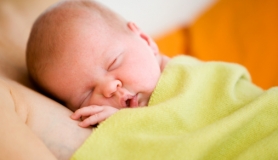We’re now recognizing scientifically (something that traditionally we have always known) that physiological birth is an ideal start to life for a baby; it seeds their microbiome, which protects them from pathogens, immune and gastrointestinal dysfunctions, and inflammatory diseases (1), and it compresses their bodies in the birth canal which prepares their lungs, clears their orifices for breathing and doses them with beneficial birth hormones like oxytocin. Psychology also shows us that an unmedicalised, trauma-free, ‘normal’ birth experience leaves a positive imprint on a child for all of their future relationships (2).
For the birthing person, the cocktail of hormones produced during a physiological birth has a plethora of protective and enjoyable effects; it creates an oxytocin high which can often be a euphoric, trippy or spiritual experience potentially lasting for days or weeks; it causes the natural expulsion of the placenta and a cease of bleeding; it catalyses colostrum and then milk production; it stimulates the evolutionarily protective, symbiotic bonding of the motherbaby (3), and usually makes the birthing person feel epicly proud of themselves, which is inarguably a great way to begin parenthood. For both birth parent and baby, physiological birth fulfills the ancestral, mammalian continuum that our genes are wired to expect.
So why does woman-centred birth matter?
‘Woman-centred birth’ could sound like nothing more than a trend - how could a pregnant woman not be right in the centre of her and her baby’s birth?! Picture this: a woman on a raised hospital bed with her legs, eagle spread, in stirrups. An obstetrician is seated facing the end of the bed at the height of her genitalia. There’s a sheet spread over her legs which means the obstetrician cannot see the woman’s upper half, nor can she really see the obstetrician. The OB examines her, performs an episiotomy and/or extracts the infant out of her body with the use of some kind of primitive instrument. Whilst this birth is happening, the birthing mother may feel nothing more than an inconvenient and irrelevant add-on to her vagina. She, a whole, complex human being, is not involved in this birth. It’s happening separately from her, rather than by nature, with her.
It should go without saying that surgical births have their place. They have their place when there is a serious medical emergency which is threatening the mother’s, and/or babies life. It is a shame that oftentimes these medical emergencies are a by-product of the hospital-birth stress environment, and that this is happening in countries where our levels of good health should mean that over 95% of women are physically capable of having ‘natural’ births (4).
Enter the relevance for Woman-Centred Birth.
Woman-centred birth is where birth happens with the woman, or birthing person, at the helm - they say, they decide, they request, they demand, they allow, they refuse, they own, they create, they invite, they exclude and they intuit. In less poetic terms, it’s where the birthing-person is treated like a grown-arse adult who does what the fuck they want. In this model of care, the following phrases and behaviours do not exist:
“It’s time to give you a quick examination now”
“The doctor is just going to give you a wee snip!”
“My consultant said I’m allowed to wait a few more days before I’m induced”
“You have to go into hospital now because ...”
All of the language above represents midwife-centred, or medical-centred care. And each of these examples illustrate how the female-endowed power of birth can be stripped away, piece by piece. These cases describe medicalised and intervened-with birth, and it’s quite obvious to see how far from woman-centred it is. Yet, a birth can still be physiological and midwife/medically -centred, though it may appear more subtle and less intrusive. For example:
In the grand scheme of things, these isolated examples may seem inconsequential, however the acute sensitivity and openness of a birthing person, as well as their prolactin-induced tendency towards submission, means that even the small things can have a big impact in how they respond to and view their experience. In some cases, the small things may mark the beginning degradation of the birthing parent’s feelings of control over their birth, which, within any medical system, has the potential to snowball quite easily into the obstetrician-centred birth we visualised above.
The midwife checks the baby’s heart tones every half an hour without asking
A midwife is sitting too close or chatting too loudly for the birthing persons liking
An umbilical cord is clamped and cut in order to examine a baby away from its gestational parent rather than prioritising the instinctual assessments the immediately postpartum parent will make
Woman-centred birth matters because it acknowledges equally the importance of how the birth happens, and how the woman experiences it.
In 2019, I had a freebirth. I travelled to my craniosacral therapist’s house to get a treatment whilst in labour, I hurried back home as things moved along quickly, and then I had my baby. THAT’S woman-centred birth.
24 years previous to the birth of my son, my mother gave birth to me, with only my father present, on our bathroom floor. She sought the advice of her homeopath over the phone but nothing more. THAT’S woman-centred birth.
A friend of mine recently gave birth to her third baby at home. She called a midwife at the last minute because she wanted to know if her baby was back-to-back or not. The midwife arrived and my friend stated: “I don’t want you to listen in to the heart rate, I don’t want you to do any observations, I just want you to do one exam and tell me what’s going on in there”. THAT’S woman-centred birth.
A story that circulated some of the birth world’s social media recently was one where an unlicensed midwife in the States gave birth to her tenth child after transferring HERSELF into hospital (her second hospital birth). She wrote the entire birth story online and named it: ‘The Time I Had A Freebirth In The Hospital’. THAT’S woman-centred birth.
Woman-centred birth matters because the people who have had a birth and immediate postpartum experience that they feel empowered by and proud of are initiated into the leaders, activists, changemakers and parents that the world needs. They feel powerful. They feel connected. They embody love and they often find a clarity in their voice, message and purpose. Women and people living ‘on purpose’ and guided by love have the power to build communities, reform and replace old systems, give voices to those less-heard, and create a new culture.
Birth is not the only way to become this. Crises, an innate and rare gift, years of practice and commitment, and other rites of passage also have the power to completely transform someone. And yet, given the vast majority of women/females will give birth in their lifetime, it is an opportunity that is already culturally embedded for them to access this part of themselves.
Cis hetero-normative women are also not the only people with the ability to become this. Any person giving birth has access to this divine, feminine power, which is inclusive to all female bodies. I’m yet to find a term that describes the equivalent ideal of ‘woman-centred birth’ but is inclusive to the LGBT+ community. I am only at the beginning of my journey of becoming LGBT+ competent.
The subject of woman or birthing-person centred birth is dear to my heart because I believe that how we treat birthing people correlates with and is symbolic of how we treat all vulnerable, sensitive and stigmatized people in our societies. A true midwife is a person who, through their knowledge of how to be in service to birthing people, is also in service to dying people, to sick people and to marginalized people. If it is true that a rising tide lifts all ships, then it is by centring the needs of these people that we can greatly contribute to the healing of our world.
Jaye Akosua is a birthkeeper, antenatal educator and placenta specialist living in East Sussex. She has recently launched Village Birth with a local midwife which offers radical and holistic antenatal education courses and 1-to-1 birth preparation coaching. Their upcoming course starts 3rd May, to find out more contact [email protected].
RESOURCES
email: [email protected]
Instagram: @villagebirthuk
Facebook: Village Birth
BOOKS TO READ
Ina May’s Guide to Childbirth by Ina May Gaskin - Read by millions of women around the world, this reassuring and practical guide will take the fear out of childbirth and restore your faith in the power of your body.
Birth Matters by Ina May Gaskin - Birth Matters is a spirited manifesta showing us how to trust women, value birth, and reconcile modern life with a process as old as our species.
Gentle Birth, Gentle Mothering by Dr. Sarah J. Buckley - The wisdom ad science of gentle choices in pregnancy, birth and parenting.
The Positive Birth Book by Milli Hill - Packed with vital and cutting-edge information on everything from building the ultimate birth plan, to your choices and rights in the birth room; from optimal cord clamping, to seeding the microbiome
Active Birth by Janet Balaskas - How to prepare for and experience a natural birth through yoga-based stretching exercises and massage practice.
Birth and Sex: The Power and the Passion by Sheila Kitzinger - Exploring the complexity and depth of female sexuality during pregnancy, birth, and after the baby comes
Orgasmic Birth by Elizabeth Davis - While an orgasmic birth can, for some, induce feelings of intense, ecstatic pleasure, it is ultimately about taking control of one’s own body and making the most informed decisions to have a safe, memorable, and joyful birth day.
Birth and Breastfeeding by Michel Odent - Expectant parents, midwives, doulas, childbirth educators will find this a provocative and visionary book.
Give Birth Like a Feminist by Milli Hill - From the importance of birth plans to your human rights in childbirth, and including birth stories from women across the world, this call-to-arms will help you find your voice, take an active role in your choices, and change the way you think about childbirth.
RESOURCES
1. https://www.aims.org.uk/journal/item/sowing-the-seeds
2. Odent, Michel Primal Health. Clairview, 2002.
3. ‘Motherbaby’ is a traditional term used to describe the symbiotic dyad of the birth parent and their baby. I use it to highlight the interconnected-ness of this pair, and not to exclude the birth parents that do not identify as mothers.
4. The statistics at The Farm in Tennessee in the 1970’s were that over 98% of women were capable of having their homebirths - this is a micro example of the general population of western women who do not suffer from poverty, are in good nutrition and health, and before stringent regulations were put upon licensed midwifery. Gaskin, Ina May, Spiritual Midwifery, Book Publishing Company 2002



1_278_160_c1.png)



